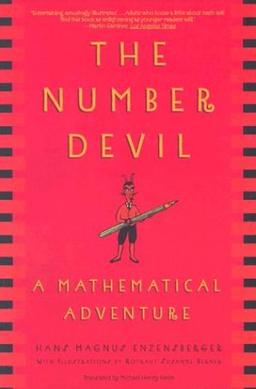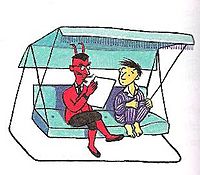The Number Devil facts for kids

The Number Devil: A Mathematical Adventure cover
|
|
| Author | Hans Magnus Enzensberger |
|---|---|
| Translator | Michael Henry Heim |
| Illustrator | Rotraut Susanne Berner |
| Cover artist | Rotraut Susanne Berner |
| Country | Germany |
| Language | German |
| Genre | Children's book |
| Publisher | Henry Holt and Company |
|
Publication date
|
1997 |
|
Published in English
|
1998 |
| Media type | Paperback/Hardcover |
| Pages | 261 |
| ISBN | 0-8050-6299-8 |
The Number Devil: A Mathematical Adventure (German: Der Zahlenteufel. Ein Kopfkissenbuch für alle, die Angst vor der Mathematik haben) is a book for children and young adults that explores mathematics. It was originally written in 1997 in German by Hans Magnus Enzensberger and illustrated by Rotraut Susanne Berner. The book follows a young boy named Robert, who is taught mathematics by a sly "number devil" called Teplotaxl over the course of twelve dreams.
The book was met with mostly positive reviews from critics, approving its description of math while praising its simplicity. Its colorful use of fictional mathematical terms and its creative descriptions of concepts have made it a suggested book for both children and adults troubled with math. The Number Devil was a bestseller in Europe, and has been translated into English by Michael Henry Heim.
Plot
Robert is a young boy who suffers from mathematical anxiety due to his boredom in school. His mother is Mrs. Wilson. He also experiences recurring dreams—including falling down an endless slide or being eaten by a giant fish—but is interrupted from this sleep habit one night by a small devil creature who introduces himself as the Number Devil. Although there are many Number Devils (from Number Heaven), Robert only knows him as the Number Devil before learning of his actual name, Teplotaxl, later in the story.
Over the course of twelve dreams, the Number Devil teaches Robert mathematical principles. On the first night, the Number Devil appears to Robert in an oversized world and introduces the number one. The next night, the Number Devil emerges in a forest of trees shaped like "ones" and explains the necessity of the number zero, negative numbers, and introduces hopping, a fictional term to describe exponentiation. On the third night, the Number Devil brings Robert to a cave and reveals how prima-donna numbers (prime numbers) can only be divided by themselves and one without a remainder. Later, on the fourth night, the Number Devil teaches Robert about rutabagas, another fictional term to depict square roots, at a beach.
For a time after the fourth night, Robert cannot find the Number Devil in his dreams; later, however, on the fifth night, Robert finds himself at a desert where the Number Devil teaches him about triangular numbers through the use of coconuts. On the sixth night, the Number Devil teaches Robert about the natural occurrence of Fibonacci numbers, which the Number Devil shortens to Bonacci numbers, by counting brown and white rabbits as they reproduce multiple times. By this dream, Robert's mother has noticed a visible change in Robert's mathematical interest, and Robert begins going to sleep earlier to encounter the Number Devil. The seventh night brings Robert to a bare, white room, where the Number Devil presents Pascal's triangle and the patterns that the triangular array displays. On the eighth night, Robert is brought to his classroom at school. The Number Devil arranges Robert's classmates in multiple ways, teaches him about permutations, and what the Number Devil calls vroom numbers (factorials).
On the ninth night, Robert dreams he is in bed, suffering from the flu, when the Number Devil appears next to him. The Number Devil teaches Robert about natural numbers, which the Number Devil calls garden-variety numbers, the unusual characteristics of infinite, and infinite series. Robert finds himself at the North Pole, where the Number Devil introduces irrational numbers (unreasonable numbers), as well as aspects of Euclidean geometry, such as vertices (dots) and edges (lines). By the eleventh night, Robert has shown considerable increased interest in mathematics, but questions its validity, to which the Number Devil introduces the concept of mathematical proofs, ending with the Number Devil showing Robert a complicated proof of basic arithmetic. On the twelfth night, Robert and the Number Devil receive an invitation (which names the Number Devil as Teplotaxl) to Number Heaven, as Robert's time with the Number Devil has finished. At Number Heaven, Robert learns of imaginary numbers, which Teplotaxl describes as imaginative numbers, as well as the Klein bottle. Walking through Number Heaven, Teplotaxl introduces Robert to various famous mathematicians, such as Fibonacci, whom Teplotaxl calls Bonacci, and George Cantor, or Professor Singer. The book ends with Robert in class using his newfound mathematical knowledge.
See also
 In Spanish: El diablo de los números para niños
In Spanish: El diablo de los números para niños


